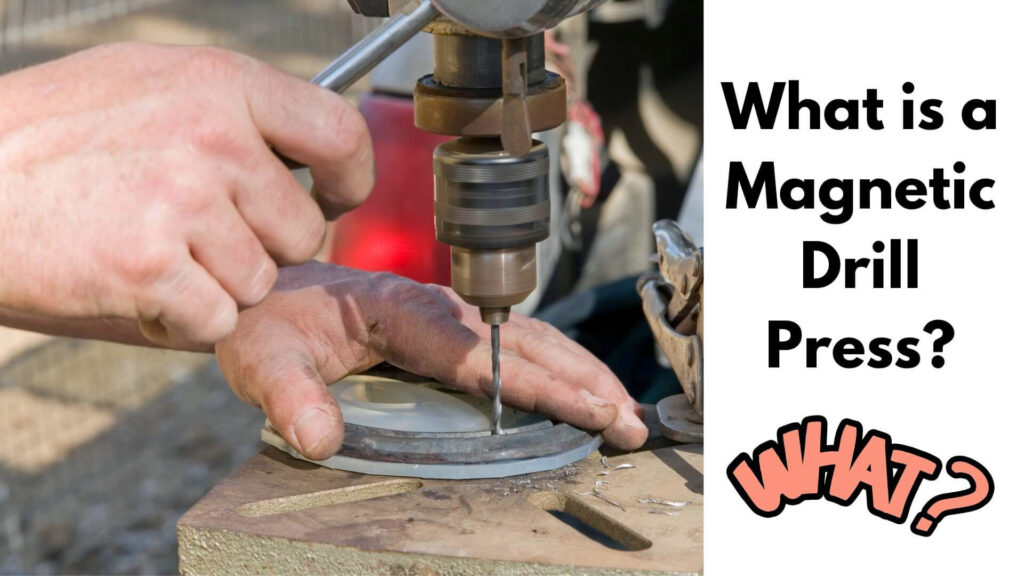In the world of metalworking and construction, efficiency, precision, and versatility are paramount. One tool that embodies these qualities is the magnetic drill press. This specialized drilling machine has gained popularity among professionals and DIY enthusiasts alike for its ability to deliver accurate results, especially in challenging environments. In this post, we will explore what a magnetic drill press is, how it works, its advantages, different types, key features, applications, and essential maintenance tips.
Table of Contents
What is a Magnetic Drill Press?
A magnetic drill press, commonly referred to as a mag drill, is a portable drilling machine designed specifically for use on ferromagnetic surfaces, such as steel and iron. The defining feature of this tool is its magnetic base, which allows it to securely attach to metal workpieces, providing stability and precision during the drilling process.
Magnetic drill presses are ideal for creating holes in thick materials, particularly in situations where traditional drill presses may not be practical, such as job sites or tight spaces. They are widely used in industries such as construction, shipbuilding, and metal fabrication.
Key Components of a Magnetic Drill Press
To fully understand how a magnetic drill press functions, it’s essential to familiarize yourself with its key components:
- Magnetic Base: The most critical feature, the magnetic base creates a strong magnetic field that allows the drill to adhere securely to ferromagnetic surfaces. This feature prevents the drill from slipping during operation.
- Drill Motor: The motor powers the drill bit and determines the drill’s performance. Most magnetic drill presses have powerful motors that can handle heavy-duty tasks.
- Drill Bit Chuck or Arbor: This component holds the drill bit in place. Depending on the model, it may accommodate various drill bits, such as twist drill bits or annular cutters.
- Feed Mechanism: This allows the operator to control the downward pressure applied to the drill bit. It can be manual or automatic, depending on the design of the drill press.
- Control Panel: The control panel typically features switches for operating the drill, controlling speed, and activating the magnetic base.
- Coolant System: Some models include a coolant system that helps lubricate and cool the drill bit during operation, especially when drilling through hard materials.
How Does a Magnetic Drill Press Work?
The operation of a magnetic drill press is relatively straightforward. Here’s a step-by-step overview of how it works:
Completion: After drilling the hole, the operator turns off the drill and disengages the magnetic base, allowing the tool to be removed from the workpiece.
Preparation: Before using the magnetic drill press, the operator must ensure that the magnetic base is clean and free of debris. This ensures a strong magnetic connection to the workpiece.
Positioning: The magnetic base is positioned on the desired drilling location on the metal surface. Once aligned, the operator engages the magnetic switch, activating the magnet and securing the drill press in place.
Drilling: The operator selects the appropriate drill bit and inserts it into the chuck or arbor. After adjusting the feed mechanism, the operator powers on the drill. The drill bit penetrates the material, creating the desired hole. If equipped with a coolant system, lubrication is applied to reduce friction and heat.
Read More: what is an oscillating drill press
What are the Benefits of using a Magnetic Drill Press?

Magnetic drill presses offer several advantages over traditional drilling methods, making them an excellent choice for various applications:
1. Portability
Magnetic drill presses are designed to be lightweight and portable, allowing users to transport them easily to different job sites. This portability is crucial for contractors and metalworkers who work in various locations.
2. Precision and Accuracy
The magnetic base secures the drill in place, reducing vibrations and movement during operation. This stability ensures that the holes drilled are accurate and precisely positioned.
3. Versatility
Magnetic drill presses can be used for various drilling tasks, including drilling, tapping, and reaming. They can accommodate different drill bit types, enhancing their versatility for various applications.
4. Ease of Use
Operating a magnetic drill press is relatively straightforward, making it accessible for both professionals and DIY enthusiasts. With a little practice, users can quickly learn to set up and operate the tool effectively.
5. Safety
The strong magnetic hold minimizes the risk of the drill slipping during operation, reducing the likelihood of accidents. Additionally, many magnetic drill presses come with safety features to protect users during operation.
Read More: How to Use Magnetic Drill Press?
Types of Magnetic Drill Presses
Magnetic drill presses come in various models and configurations to suit different needs. Here are the primary types:
1. Standard Magnetic Drill Presses
These are the most common type of magnetic drill press. They typically feature a robust design, powerful motors, and the ability to handle a wide range of drilling tasks. Standard magnetic drill presses are suitable for heavy-duty applications and can drill through thick materials.
2. Compact Magnetic Drill Presses
Compact magnetic drill presses are designed for portability and ease of use. They are lighter and smaller than standard models, making them ideal for tight spaces and jobs requiring mobility. Despite their size, they still deliver excellent drilling performance.
3. Heavy-Duty Magnetic Drill Presses
Heavy-duty magnetic drill presses are built for industrial applications, featuring powerful motors and enhanced durability. These models are capable of handling tough materials and can be used for extended periods without overheating.
4. Combination Magnetic Drill Presses
Combination models incorporate features from both magnetic drill presses and traditional drill presses. They may offer additional functionalities, such as milling or grinding capabilities, making them versatile tools for various applications.
Key Features to Look for When Buying a Magnetic Drill Press
When selecting a magnetic drill press, consider the following key features:
1. Magnetic Hold Strength
The strength of the magnetic base is crucial for stability during drilling. Look for models that provide a strong magnetic hold to ensure safe operation.
2. Motor Power
Choose a drill press with a powerful motor that can handle the materials you plan to work with. Higher horsepower ratings typically translate to better performance.
3. Drilling Capacity
Consider the maximum drilling capacity, including the thickness of materials the drill can handle. Ensure the model meets your specific needs.
4. Feed Mechanism
Evaluate the feed mechanism to determine if it is manual or automatic. Automatic feed mechanisms can enhance efficiency, while manual options provide more control.
5. Coolant System
If you plan to drill through hard materials, a coolant system can help prolong the life of your drill bits and improve overall performance.
6. Weight and Portability
Consider the weight of the drill press, especially if you need to transport it frequently. Lighter models are easier to move but ensure they still meet your drilling requirements.
7. Safety Features
Look for models equipped with safety features, such as overload protection and emergency shut-off switches, to enhance user safety.
Applications of Magnetic Drill Presses
Magnetic drill presses are used in various industries and applications, including:
1. Construction
Magnetic drill presses are commonly used in construction for drilling holes in steel beams, columns, and other structural components.
2. Metal Fabrication
In metal fabrication shops, these drills are essential for creating precise holes in metal components, whether for assembly or finishing.
3. Shipbuilding
Magnetic drills are ideal for shipbuilding, where drilling needs to be done in challenging positions, such as overhead or at awkward angles.
4. Maintenance and Repair
Magnetic drill presses are often used for maintenance and repair tasks, allowing technicians to drill holes in machinery and equipment on-site.
5. Manufacturing
In manufacturing environments, magnetic drills are used for batch production of parts, ensuring consistent quality and efficiency.
Maintenance Tips for Magnetic Drill Presses
Proper maintenance is essential to keep your magnetic drill press in optimal condition. Here are some tips:
1. Regular Cleaning
After each use, clean the magnetic base and drill components to remove metal shavings and debris. This prevents contamination and ensures a secure magnetic hold.
2. Inspect the Drill Bits
Check drill bits for wear and damage regularly. Replace dull or damaged bits to maintain drilling efficiency and accuracy.
3. Lubricate Moving Parts
Lubricate moving parts as recommended by the manufacturer to prevent wear and ensure smooth operation.
4. Check Electrical Components
Inspect the power cord and electrical components for any signs of wear or damage. Replace any faulty components immediately to ensure safety.
5. Store Properly
When not in use, store the magnetic drill press in a dry and secure location. Protect it from moisture and extreme temperatures to prolong its lifespan.
Conclusion
A magnetic drill press is a valuable tool for anyone working in metalworking, construction, or fabrication. Its portability, precision, and versatility make it an excellent choice for various applications. By understanding its features, advantages, and maintenance requirements, users can maximize the benefits of this powerful tool.
Whether you are a professional contractor or a DIY enthusiast, investing in a magnetic drill press can significantly enhance your drilling capabilities, allowing you to tackle even the most challenging projects with confidence.

Hey, I am MD Hrithik Hossain, I’m a huge fan of DIY crafts. My workshop is where I spend most of my spare time, and I’m always working on some project. To that end, I’d like to share some of my knowledge and experience with you in power tools, woodworking, and other specialized materials fabrication.
I will guide you with genuine knowledge that can assist you with deciding whether a drill is appropriate according to your requirements or not. If you want to find the best drill and know which type of drill is most suited for your needs, then I can guide you with my expertise. My passion lies in helping others find the correct products they need at an affordable price.


